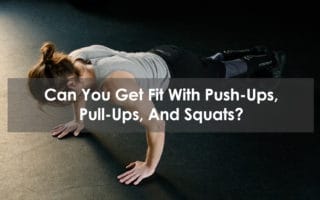Time and time again, resistance training has been linked to helping prevent disease and improve our overall health and well-being, but what type of exercise is best? Here I’ll look at two specifically, calisthenics vs. weight lifting.
It is generally suggested keeping your efforts light to moderate, though when it comes to weight training and other plyometric movements.
Both activities improve your body composition, especially in regards to fat loss; they also enhance motor skills and have a beneficial effect on bone health.
This article aims to provide you, the reader, with invaluable information such as; pros and cons, how to correctly perform the movement, who is suited to each exercise, and the overall benefits of calisthenics and weightlifting have on our bodies.
Calisthenics
Calisthenics uses multiple muscle groups as a modality of training that consists of bodyweight exercises that are scientifically referred to as “gross motor movements.” These movements and exercises use large muscle groups and are important foundationally when talking about everyday activities such as walking, running, and even standing.
The benefits of calisthenics movements are seen as rhythmical and low impact, emphasizing bodyweight training movements like a push-up, pull-ups on a pullup bar, and sit-ups. It provides muscular and cardiovascular benefits as well as improving skills such as balance and agility.
There are various types of calisthenics, and one that is gaining recent popularity is “urban calisthenics.” It’s essentially performed in large groups in urban outdoor areas, training, and performing advanced skills like levers, spins, freestyle moves, and muscle-ups.
Another style of calisthenics is “co-operative calisthenics.” In this form, generally, two or more people are needed to perform the workout focusing on body awareness. These exercises, though, are more commonly referred to as “partner exercises.”
An example of this would be doing squats with a partner on your back.
What To Do:
Exploiting physics by changing body position is essential when it comes to increasing resistance in calisthenics. Unlike weightlifting, where you can “stack the rack,” calisthenic exercises use bodyweight, so if you are 75kgs, then 75kgs is all you have. That’s where physics plays a vital role in taking calisthenics to the next level.
Things you can do to increase resistance:
- By raising your feet, you will put more weight on your hands.
- Keep your hands lower on your body, closer to your waist, and further from your shoulders
- When holding bars, take a narrower grip; this focuses emphasis on the smaller triceps muscle.
The technique is king when it comes to performing calisthenics. Because of the complexity of the movements, learning and maintaining the correct form is of paramount importance. Unlike weight training, where cheating on exercises is somewhat accepted, cheating on form in calisthenics can lead to serious injury.
Calisthenics is a progressive strength modality, meaning you need to respect the level you are currently at before learning the next movement or level of difficulty. Remember, small steps equal one quantum leap in progression over time; the old cliche; life is a journey” rings true with calisthenics.
What Not To Do:
Training to failure is often seen as a “must,” those that train to failure are hardcore; how many times have you heard that? Yet when performing calisthenics or bodyweight movements, not maxing out is recommended. When you max out, you run the risk of losing form and therefore increasing the chance of injury.
Don’t let so-called “friends” put you down when you perform calisthenics. Don’t let them tell you, “weightlifting or bodybuilding is better.” Everyone has their own unique goals. Variety in training is a good thing.
Who Is It For?
Anyone with a decent amount of strength can perform calisthenics and reap its full benefits. In saying that though groups like the military and police use calisthenics extensively in their training.
The U.S. Army actually includes several calisthenics exercises in their physical evaluations. Activities such as push-ups, pull-ups, and sit-ups are all included and form the baseline for their assessment.
In some countries, calisthenics has recently been viewed as an essential physical education component in primary and secondary schools, due to the overwhelming benefits of the movement, especially in developing early childhood motor skills.
Pros:
- Very inexpensive, building a home gym or buying gym memberships can be expensive.
- The ability to train anywhere.
- Improves functional strength.
- Improves your workout effort.
- Improves balance and agility.
- Improves health and burns calories.
- Low impact equals a reduction in injury.
Cons:
- Challenging to build muscle mass.
- The movements can be complicated.
- A reasonably high level of fitness and strength is required even for beginners.
Weightlifting
Strength training is a standard resistance training modality that can develop the size and strength of your muscles when performed correctly and has been shown to significantly reduce the chance of chronic disease.
Weighted barbells, dumbbells, kettlebells, and various other equipment are used to build strength by utilizing gravity, concentric, and eccentric contractions to provide the counterforce to target specific muscles and muscle groups.
Strength training or “weight-training” is used by many different types of people, particularly those involved in sports either as a hobby or as a professional athlete.
Some of those sports are; soccer, football, basketball, rowing, rugby, and boxing.
Muscle strength is governed by the basic principles that are essentially the same as gaining muscle weight training. The principles revolve around manipulating various training factors, such as; the sets you perform, how many repetitions, the types of exercise, intensity, and endurance.
Various types of weights will offer different resistance forces. Although, they may weigh the same, e.g.) pulling a 20kg weight with a barbell will sometimes require more energy than pulling 20kgs on a machine that utilizes a pulley system.
The opposite can also be true; on occasion, the machine’s weight stack may require more force than the free weight due to the torque or resistance provided by the machine.
What To Do?
A perfect example of poor form and technique in the weight lifting world is the traditional squat and deadlift. These two movements utilize the largest muscle group, the leg and glute muscles, meaning they require considerable weight. In these two movements, those new to weightlifting exercises tend to arch their backs, causing friction in the lumbar spine, potentially causing significant damage.
An active warm-up of between 10-15 minutes is recommended to get heat into the muscles, helping prevent injury sufficiently. Warming up correctly allows you to lift heavier and engage secondary muscle groups and the primary muscle being worked.
Breathing patterns are fundamental when it comes to getting the most out of your weight lifting. To breathe correctly, follow this easy rule: breathe in or “inhale” when lowering the bar (referred to as the eccentric move,” and breathe out or “exhale” when lifting the weight back to the start position called the (concentric movement).
Avoiding dehydration throughout the duration of the activity is essential when lifting weights. Sweating is the main culprit in fluid loss, so it’s critical to stay hydrated throughout the workout to stave off exhaustion, which can present as heat-stroke symptoms. Electrolyte drinks are a great way to stay hydrated and prevent muscle cramps and fatigue.
Any exercise, activity, or movement in which you feel pain should be stopped immediately. Experience lifters will understand, though, that not all pain or discomfort indicates an injury. More often than not, it’s harmless muscle fatigue brought on by intense training. However, regardless of your program, most people undertaking weight lifting will experience muscle fatigue at one time or another.
If you’re new to weight lifting, it’s recommended to start slowly. Once or twice a week will suffice with durations of no longer than 45 minutes to an hour. Use weights that are light and easy for you to complete 3 sets of 12. It would be best to build a strong foundation first, particularly the core muscles that help stabilize you and provide good posture.
Building slowly gives the body time to develop in a balanced manner, minimizing injury and muscle soreness. A structured stretching routine should be implemented into any weightlifting program as it’s critically important to maintain flexibility in the muscles and joints.
What Not To Do?
- Do not start weight lifting without correctly warming up.
- Do not lift heavier than you can.
- Do not start weight lifting without consulting your health care professional first.
- Do not forget to stretch.
Who Is It For?
Calisthenics vs weights is an excellent training modality for almost everyone. It provides numerous physical and mental health benefits including weight loss, improved posture, elevated metabolism, functional support, osteoporosis prevention, and self-esteem.
The elderly can benefit significantly from incorporating weight lifting into their daily routine. As the body ages, we lose muscle mass. Our functional strength is diminished dramatically; weight lifting helps keep the muscles more robust, providing longevity and a healthier lifestyle.
Those undergoing rehabilitation can also greatly benefit from regular weight lifting. Strength training optimizes recovery of the injury, particularly after orthopedic surgery, and helps boost the immune system.
People who play a sport will benefit from weight lifting, and they have the added benefit of employing “sport-specific” training into their programs, using both free weights and machines.
Pros:
- Increased muscle development and calories burned.
- An increase in strength.
- Increased functional mobility.
- Provides various forms of strength training.
- Longevity.
- Increased heart health.
- Mental freshness and clarity.
- Stress relief.
Cons:
- Chance of injury.
- Gym memberships can be costly.
- Weightlifting moves can be complex.
Conclusion
Depending on several personal factors such as; fitness goals, fitness level, muscle size, age, building muscle, and time, both calisthenics and weight lifting provide you with a plethora of positive benefits.
Generally, it is accepted that strength training exercise does increase the chance of injury when compared to calisthenics or other plyometric movements. However, if performed with the correct technique and under expert tuition using the appropriate amount of weight, lifting weights becomes an excellent training modality for most people, including children and the elderly.
Calisthenics is a low-impact compound movement giving you quality results with limited impact on your body. Still, as with weight lifting, I recommend seeking expert advice from a qualified personal trainer or coach who can advise you on proper form and provide you with a tailored fitness regimen.
Frequently Asked Questions
Is Calisthenics Better Than Weight Lifting?
Calisthenics is what we refer to as a “compound movement,” meaning it requires quite a high level of strength to perform correctly; however, if performed with the correct technique, resistance can be added in a variety of ways to intensify the movement.
On the other hand, if your primary goal is to build muscle, I would suggest weight training three times a week, coupled with a quality nutritional plan.
Can You Build Muscle With Only Calisthenics?
As previously mentioned, calisthenics is classified as a compound movement, meaning you are utilizing your full body; thus, not only can you build muscle but “quality muscle” by performing calisthenics on a consistent basis.
The added benefit is that calisthenics provides your body with a full workout, gives you a more natural look, and strengthens the body helping to prevent injury.
What Burns More Fat, Calisthenics, Or Weight Training?
When it comes to which activity, calisthenics, or “body weight training” vs. lifting weights burns more fat, it depends on several factors. Both workouts will burn fat when performed appropriately.
Performing them in a H.I.I.T. (High-Intensity Interval Training ) or a circuit training style workout, you’ll get the best result out of both exercises when it comes to burning calories.







